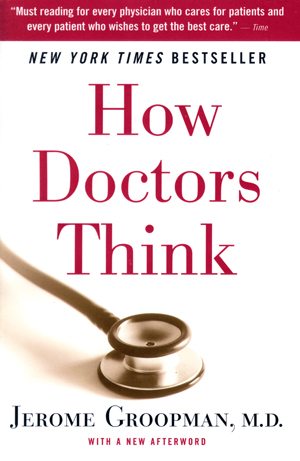
June 26th, 2010 by AndrewSchorr in Better Health Network, Opinion, True Stories
Tags: Andrew Schorr, Apps, Books on the Internet, Electronic Books, Empowering Patients, Health-Conscious Consumers, Healthcare Consumers, iPhone IV, Multi-Format, Multi-Media, New York Publishing World, Non-Fiction, Online Books, Online Health World, Patient Empowerment, Patient Power, Print Publishing, Smartphones, Technology Gap, The Web Savvy Patient, Web-Based Publishing
No Comments »

The book publishing world, largely based in New York City, is in trouble. The fragmentation of the market by electronics large and small has chopped former readers into so many pieces. How can a publisher make a blockbuster buck anymore? The answer may come in translations of Swedish fiction from a newly-found novelist, now dead, to non-fiction ghostwritten for a face everyone knows from the evening news.
In a whirlwind face-to-face series of meeting with publishers on a very recent sunny Tuesday in Manhattan, I got a glimpse of their angst and did my best to convince them that a book — yes, even all sorts of electronic versions and in-the-palm-of-your-hand “apps” — could make them boatloads of money and do the right thing for America’s healthcare consumer (just maybe such a work could be translated into Swedish and do good there in a return of the favor literary effort). Read more »
*This blog post was originally published at Andrew's Blog*
June 26th, 2010 by KevinMD in Better Health Network, Health Policy, Health Tips, Opinion, Research
Tags: Amy Ship, Beth Israel Deaconess Medical Center, Cellphones, Cognitive Function, Distracted Drivers, Doctor-Patient Communication, Family Medicine, General Medicine, Hands-Free Device, Internal Medicine, Multitask, Neurology, Neurons, New England Journal of Medicine, Preventive Health, Preventive Medicine, Primary Care, Public Awareness, Public Health, Public Safety, Text And Drive, Traffic Accidents
No Comments »

It’s time to ask patients whether they text and drive. An important perspective piece from the New England Journal of Medicine urges doctors to include that question during preventive health exams. The data surrounding texting and driving is grim:
Although there are many possible distractions for drivers, more than 275 million Americans own cell phones, and 81% of them talk on those phones while driving. The adverse consequences have reached epidemic proportions. Current data suggest that each year, at least 1.6 million traffic accidents (28% of all crashes) in the United States are caused by drivers talking on cell phones or texting. Talking on the phone causes many more accidents than texting, simply because millions more drivers talk than text; moreover, using a hands-free device does not make talking on the phone any safer.
The author of the piece, Amy Ship from Boston’s Beth Israel Deaconess Hospital, says that doctors should update traditional preventive questions to keep up with the times. The simple question, “Do you text while you drive?” is a way to start this important conversation. Read more »
*This blog post was originally published at KevinMD.com*
June 25th, 2010 by Bryan Vartabedian, M.D. in Better Health Network, Book Reviews, Opinion
Tags: Fulfillment of Fantasy, General Medicine, How Doctors Think, How Patients Think, Jerome Groopman, Patient Empowerment, Patient-Doctor Relationship, Physician Hero, Physician-Centric, Reading, The Decision Tree, Thomas Goetz
1 Comment »

 If you want to see the difference between how doctors and patients think, read Jerome Groopman’s “How Doctors Think” and Thomas Goetz’s “The Decision Tree.” The contrast is striking.
If you want to see the difference between how doctors and patients think, read Jerome Groopman’s “How Doctors Think” and Thomas Goetz’s “The Decision Tree.” The contrast is striking.
“How Doctors Think,” while offering a comprehensive review of the cognitive missteps made by physicians, is terminally physician-centric in its analysis of the relationship we share with patients. “The Decision Tree,” while offering a novel blueprint for self-reliance in health, seems almost sheepish in its recognition that physicians are even really that important. The muted physician cameos of “The Decision Tree” stand in stark contrast to Groopman’s Harvard-trained masters of the universe. Read more »
*This blog post was originally published at 33 Charts*
June 25th, 2010 by Happy Hospitalist in Better Health Network, Humor, Opinion
Tags: Diarrhea Clinic, Family Medicine, General Medicine, Hospitalist, Internal Medicine, International Medicine, International Travel, Internist, Medical Humor, Primary Care, Traveler's Diarrhea
No Comments »

 I’m not sure what country this photo was snapped in, but the clinic owners were smart enough to help international travelers seek care for traveler’s diarrhea. There’s no beating around the bush on this one. If you’re in this waiting room staring at strangers, they’re all going to know why you’re there.
I’m not sure what country this photo was snapped in, but the clinic owners were smart enough to help international travelers seek care for traveler’s diarrhea. There’s no beating around the bush on this one. If you’re in this waiting room staring at strangers, they’re all going to know why you’re there.
Diarrhea Clinic — that’s simple brilliance. That doctor needs to be hired by the ACP and SHM and ABIM to help us answer questions like “What is an internist?” and “What is a hospitalist?” For these doctors, everyone knows exactly what he does — no questions necessary.
*This blog post was originally published at The Happy Hospitalist*
June 24th, 2010 by RamonaBatesMD in Better Health Network, Health Policy, Opinion, Research
Tags: Body Image, Dr. 90210, Dr. Gary Alter, E! Network, Female Cosmetic Genital Surgery, Female Sexual Problems, Female Sexuality, First Do No Harm, Genital Appearance, Gynecology, Labia Minora Reduction, Labioplasty, Marge Berer, Mental Health, Plastic and Reconstructive Surgery, Plastic Surgeons, Psychiatry, Psychology, Reproductive Health Matters, Risk of Complications, Self Esteem, Self Image, Sexual Health, Sexual Inhibition, Vulva Reduction Surgery, Women's Health
No Comments »

I seem to be asked more often these days if I do vulva reduction surgery. I’ve even been asked if I “refresh” vaginas (in which I refer them to their gynecologist.) I’m happy it’s a extremely small part of my practice.
I’m also happy to see that the current issue of Reproductive Health Matters is taking a close look at cosmetic surgery, especially female cosmetic genital surgery. Read more »
*This blog post was originally published at Suture for a Living*






 If you want to see the difference between how doctors and patients think, read Jerome Groopman’s “How Doctors Think” and Thomas Goetz’s “The Decision Tree.” The contrast is striking.
If you want to see the difference between how doctors and patients think, read Jerome Groopman’s “How Doctors Think” and Thomas Goetz’s “The Decision Tree.” The contrast is striking.
 I’m not sure what country this photo was snapped in, but the clinic owners were smart enough to help international travelers seek care for traveler’s diarrhea. There’s no beating around the bush on this one. If you’re in this waiting room staring at strangers, they’re all going to know why you’re there.
I’m not sure what country this photo was snapped in, but the clinic owners were smart enough to help international travelers seek care for traveler’s diarrhea. There’s no beating around the bush on this one. If you’re in this waiting room staring at strangers, they’re all going to know why you’re there.








